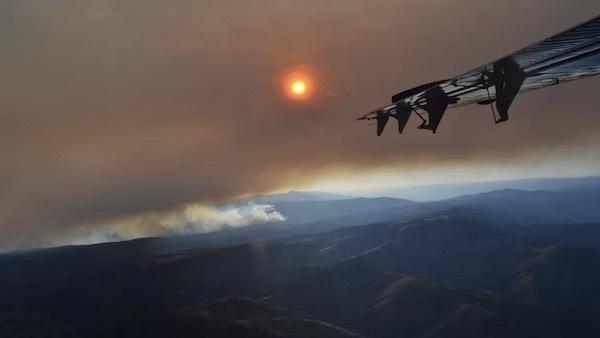
Among the complex mix of particles that make up wildfire smoke, an abundant but thus far unknown kind has been shown to trap a surprising amount of heat, according to new research.
These results indicate that wildfires, which are expected to become harsher and more frequent in the coming years due to human-induced climate change, are heating Earth to a greater extent than previously thought.
Using NASA's Douglas DC-8 aircraft, which is a 54-year-old quadjet (a jet powered by four engines) that was turned into a flying science lab, scientists performed smoke analysis of three specific lightning-caused fires. All three had burnt large swaths of land in the western United States in 2019 — the Shady Creek in Idaho, Castle and Ikes in Arizona and the 204 Cow of Oregon.
Their findings showed that a new kind of particle associated with these fires, dubbed organic "dark brown carbon," strongly absorbs heat — so much so that they account for more than half of the total heat absorbed by the collected wildfire smoke.
"It's likely that they form similarly to soot in the high-temperature flames along the leading edges of wildfires," Rohan Mishra, an associate professor of mechanical engineering and materials science at Washington University in St. Louis, Missouri and a co-author of the new study, said in a statement.
In July and August of 2019, scientists used instruments onboard NASA's flying science lab to collect smoke samples at about 6.2 miles (10 km) above ground. On ground, they used a mobile laboratory to collect samples of wildfire smoke about 1.8 miles (3 km) from selected fire management areas.
Related: Satellites watch as wildfires rage across Greece (photos)
Granite Gulch Fire, during August 2019. (Credit: NOAA OMAO)
The new particles are fewer in number when compared to another wildfire smoke particle known as black carbon or soot, which absorbs sunlight, then turns that sunlight into heat. Black carbon is the second largest contributor to global warming after carbon dioxide — however, these newly studied dark brown carbon particles appear to be four times more abundant in smoke than black carbon. That ultimately spikes the potential for wildfires to warm our planet far beyond what has been accounted for.
The results of this latest research, which was a collaboration between NASA and the National Oceanic and Atmospheric Administration (NOAA), add a strong urgency to better understand the warming effects of brown carbon. These particles are technically included in existing climate models, but their warming effects remain a huge uncertainty, and it's also worth noting that they're released into the atmosphere during the burning of fossil fuels as well.
"Typically, climate models ignore or dismiss organic carbon as insignificant compared to black carbon when it comes to warming, but that is not what field observations reveal," Rajan Chakrabarty, an associate professor of energy, environment and chemical engineering at the Washington University in St. Louis and the new study's lead author, said in the statement.
The newly found particles seem to absorb light across the visible spectrum, from ultraviolet wavelengths to near-infrared. They are also capable of resisting light-induced bleaching, which is a naturally occurring process that's expected to strip brown carbon particles of their capacity to absorb heat, usually within a day after they're released into the atmosphere.
However, lab experiments showed that the dark brown carbon particles indicated no change in heat absorption for at least three days.
Previous research has shown that such bleaching is "heavily dependent" on the height of the smoke and local atmospheric conditions. Closer to the ground, where there are higher chances of warm and humid climates, brown carbon loses its color or bleaches in as quickly as a day.
The higher the wildfire smoke is from the ground, the cooler the air gets, so brown carbon in the smoke loses its water content, making chemical reactions that much harder. At high altitudes, it wafts in the atmosphere for as long as a year.
In the past, wildfire smoke has drifted to polar regions, and brown carbon was cited as the leading contributor to the accelerated melting of glaciers and sea ice in the Arctic, which is now warming faster than the rest of the planet.
The new paper was published on Monday (Aug. 07) in the journal Nature Geoscience.







